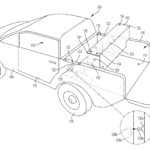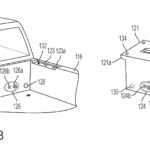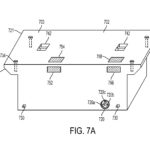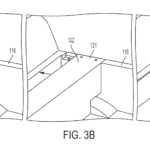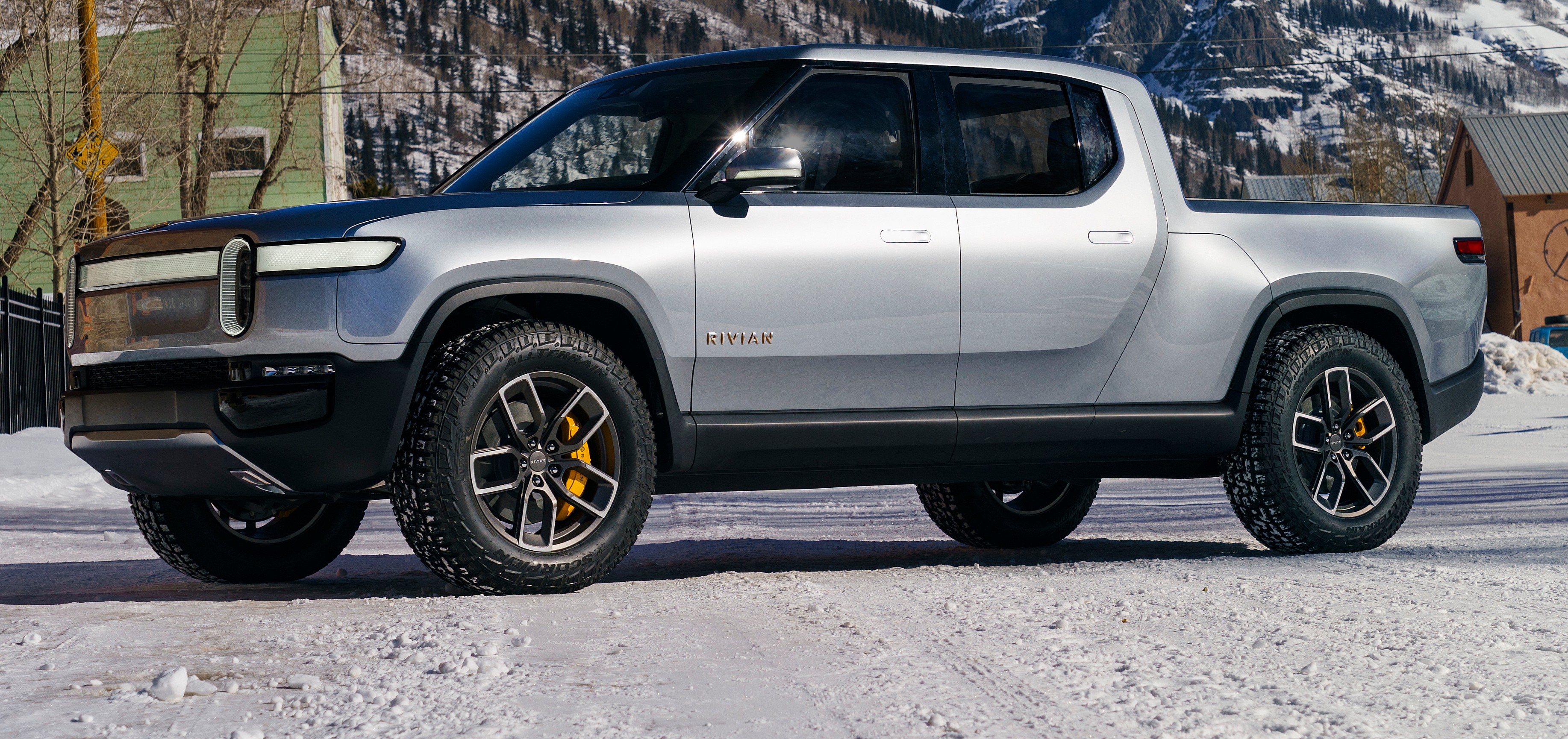

News
Rivian patent reveals R1T auxiliary battery that pushes range beyond 400 miles
Rivian CEO RJ Scaringe previously mentioned that his electric truck company is developing an auxiliary battery that acts as a “digital jerry can” for its vehicles, allowing them to travel beyond their listed range. Thanks to a recently published patent application, more details on this auxiliary battery system are now available.
The patent, titled “Electric Vehicle With Modular Removable Auxiliary Battery With Integrated Cooling,” describes an external battery module that can be fitted to an electric vehicle, thereby providing it with additional range. This is especially important for Rivian’s trucks, since they are designed to go off-road. Thus, the company notes that there is a need for an “auxiliary battery system for an electric automotive vehicle to increase the range of the electric vehicle, and in particular, an auxiliary battery system that can be carried by the electric vehicle.”
As could be seen in the patent application, the auxiliary battery system would be installed on the cargo area of a truck. In the case of the R1T pickup, for example, the battery module would be fitted on the truck’s bed. The entire module also includes latching mechanisms and connectors, which are designed for easy installation and removal.
- Illustrations depicting Rivian’s auxiliary battery system. (Photo: Rivian Automotive)
- Illustrations depicting Rivian’s auxiliary battery system. (Photo: Rivian Automotive)
- Illustrations depicting Rivian’s auxiliary battery system. (Photo: Rivian Automotive)
- Illustrations depicting Rivian’s auxiliary battery system. (Photo: Rivian Automotive)
Illustrations depicting Rivian’s auxiliary battery system. (Photo: Rivian Automotive)
Perhaps more impressively, Rivian’s design for its auxiliary battery utilizes the cooling systems of the vehicle itself. Upon installation of the battery unit, Rivian notes that the vehicle’s systems would perform necessary adjustments, ensuring that ride quality and driveability do not get compromised or unnecessarily changed. Rivian outlines this process in the following section:
“When outfitted with the auxiliary battery, the electric vehicle can detect the fact that the auxiliary battery is attached to (e.g., mounted in) the electric vehicle (e.g., in cargo bed) and automatically set one of multiple predetermined feature sets, e.g., that pertain to driving performance of the electric vehicle. Such feature sets may set, for example, certain suspension characteristics appropriate for the attachment of the auxiliary battery, such as, e.g., a setting for firmness of ride of the vehicle, braking performance/sensitivity, nominal suspension height, effective steering ratio, etc.”
It should be noted that the auxiliary battery module design outlined in Rivian’s recently-published patent appears to be optimized for the R1T pickup truck. Based on the illustrations provided by the company, the external battery seems to take up a substantial amount of space in the all-electric pickup’s bed. With this in mind, it remains to be seen how the company would design a similar battery solution for the R1S SUV, which does not have a bed like the R1T. Nevertheless, considering Rivian’s polished approach to its designs, it is quite exciting to see how the company would equip a seven-seater SUV with a range-extending battery module.

RJ Scaringe noted in a previous interview that one of the reasons behind Rivian’s extra large battery packs (offered at 105 kWh, 135 kWh, and 180 kWh configurations) is to ensure that drivers would have enough range for their adventure needs. This certainly appears to be the theme with Rivian’s vehicles, as could be seen in its top-tier variants’ range of 400 miles per charge. Coupled with an auxiliary battery system, the company’s trucks could very well close in or even exceed the 500-miles per charge mark.
Similar to other new automakers such as Tesla, Rivian’s first vehicles are made for the luxury niche, not the mass market. As noted by RJ Scaringe in an interview with Green Tech Media, Rivian’s target demographic are the people who are “spending $70,000 or $80,000 on a GMC Denali or a Chevy Suburban or a Land Rover Discovery or a fully loaded Ford F150.” For these potential customers, the company can tolerate no compromises, and in Scaringe’s words, “under-promise and over-deliver.” This is especially true with regards to the R1T and the R1S’ range.
Rivian’s patent application for its auxiliary battery system could be accessed here.
News
Tesla begins Robotaxi certification push in Arizona: report
Tesla seems serious about expanding its Robotaxi service to several states in the coming months.

Tesla has initiated discussions with Arizona transportation regulators to certify its driverless Robotaxi service in the state, as per a recent report from Bloomberg News. The move follows Tesla’s launch of its Robotaxi pilot program in Austin, Texas, as well as CEO Elon Musk’s recent comments about the service’s expansion in the Bay Area.
The Arizona Department of Transportation confirmed to Bloomberg that Tesla has reached out to begin the certification process for autonomous ride-sharing operations in the state. While details remain limited, the outreach suggests that Tesla is serious about expanding its driverless Robotaxi service to several territories in the coming months.
The Arizona development comes as Tesla prepares to expand its service area in Austin this weekend, as per CEO Elon Musk in a post on X. Musk also stated that Tesla is targeting the San Francisco Bay Area as its next major market, with a potential launch “in a month or two,” pending regulatory approvals.
Tesla first launched its autonomous ride-hailing program on June 22 in Austin with a small fleet of Model Y vehicles, accompanied by a Tesla employee in the passenger seat to monitor safety. While still classified as a test, Musk has said the program will expand to about 1,000 vehicles in the coming months. Tesla will later upgrade its Robotaxi fleet with the Cyercab, a two-seater that is designed without a steering wheel.
Sightings of Cybercab castings around the Giga Texas complex suggests that Tesla may be ramping the initial trial production of the self-driving two-seater. Tesla, for its part, has noted in the past that volume production of the Cybercab is expected to start sometime next year.
In California, Tesla has already applied for a transportation charter-party carrier permit from the state’s Public Utilities Commission. The company is reportedly taking a phased approach to operating in California, with the Robotaxi service starting with pre-arranged rides for employees in vehicles with safety drivers.
News
Tesla sets November 6 date for 2025 Annual Shareholder Meeting
The automaker announced the date on Thursday in a Form 8-K.

Tesla has scheduled its 2025 annual shareholder meeting for November 6, addressing investor concerns that the company was nearing a legal deadline to hold the event.
The automaker announced the date on Thursday in a Form 8-K submitted to the United States Securities and Exchange Commission (SEC). The company also listed a new proposal submission deadline of July 31 for items to be included in the proxy statement.
Tesla’s announcement followed calls from a group of 27 shareholders, including the leaders of large public pension funds, which urged Tesla’s board to formally set the meeting date, as noted in a report from The Wall Street Journal.
The group noted that under Texas law, where Tesla is now incorporated, companies must hold annual meetings within 13 months of the last one if requested by shareholders. Tesla’s previous annual shareholder meeting was held on June 13, 2024, which placed the July 13 deadline in focus.
Tesla originally stated in its 2024 annual report that it would file its proxy statement by the end of April. However, an amended filing on April 30 indicated that the Board of Directors had not yet finalized a meeting date, at least at the time.
The April filing also confirmed that Tesla’s board had formed a special committee to evaluate certain matters related to CEO Elon Musk’s compensation plan. Musk’s CEO performance award remains at the center of a lengthy legal dispute in Delaware, Tesla’s former state of incorporation.
Due to the aftermath of Musk’s legal dispute about his compensation plan in Delaware, he has not been paid for his work at Tesla for several years. Musk, for his part, has noted that he is more concerned about his voting stake in Tesla than his actual salary.
At last year’s annual meeting, TSLA shareholders voted to reapprove Elon Musk’s compensation plan and ratified Tesla’s decision to relocate its legal domicile from Delaware to Texas.
Elon Musk
Grok coming to Tesla vehicles next week “at the latest:” Elon Musk
Grok’s rollout to Tesla vehicles is expected to begin next week at the latest.

Elon Musk announced on Thursday that Grok, the large language model developed by his startup xAI, will soon be available in Tesla vehicles. Grok’s rollout to Tesla vehicles is expected to begin next week at the latest, further deepening the ties between the two Elon Musk-led companies.
Tesla–xAI synergy
Musk confirmed the news on X shortly after livestreaming the release of Grok 4, xAI’s latest large language model. “Grok is coming to Tesla vehicles very soon. Next week at the latest,” Musk wrote in a post on social media platform X.
During the livestream, Musk and several members of the xAI team highlighted several upgrades to Grok 4’s voice capabilities and performance metrics, positioning the LLM as competitive with top-tier models from OpenAI and Google.
The in-vehicle integration of Grok marks a new chapter in Tesla’s AI development. While Tesla has long relied on in-house systems for autonomous driving and energy optimization, Grok’s integration would introduce conversational AI directly into its vehicles’ user experience. This integration could potentially improve customer interaction inside Tesla vehicles.
xAI and Tesla’s collaborative footprint
Grok’s upcoming rollout to Tesla vehicles adds to a growing business relationship between Tesla and xAI. Earlier this year, Tesla disclosed that it generated $198.3 million in revenue from commercial, consulting, and support agreements with xAI, as noted in a report from Bloomberg News. A large portion of that amount, however, came from the sale of Megapack energy storage systems to the artificial intelligence startup.
In July 2023, Musk polled X users about whether Tesla should invest $5 billion in xAI. While no formal investment has been made so far, 68% of poll participants voted yes, and Musk has since stated that the idea would be discussed with Tesla’s board.
-

 Elon Musk1 week ago
Elon Musk1 week agoTesla investors will be shocked by Jim Cramer’s latest assessment
-

 Elon Musk3 days ago
Elon Musk3 days agoElon Musk confirms Grok 4 launch on July 9 with livestream event
-

 Elon Musk15 hours ago
Elon Musk15 hours agoxAI launches Grok 4 with new $300/month SuperGrok Heavy subscription
-

 News7 days ago
News7 days agoTesla Model 3 ranks as the safest new car in Europe for 2025, per Euro NCAP tests
-

 Elon Musk2 weeks ago
Elon Musk2 weeks agoA Tesla just delivered itself to a customer autonomously, Elon Musk confirms
-

 Elon Musk1 week ago
Elon Musk1 week agoxAI’s Memphis data center receives air permit despite community criticism
-

 Elon Musk2 weeks ago
Elon Musk2 weeks agoTesla’s Omead Afshar, known as Elon Musk’s right-hand man, leaves company: reports
-

 News2 weeks ago
News2 weeks agoXiaomi CEO congratulates Tesla on first FSD delivery: “We have to continue learning!”

